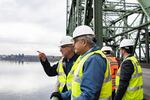A new committee with legislators from Oregon and Washington met for the first time Friday to discuss replacing the Interstate 5 bridge. After a tour of the 100-year-old bridge, all 16 members of the bipartisan group held a public hearing at Vancouver City Hall.
On Friday, Oregon lawmakers on the committee spoke of scar tissue remaining from the last attempt to replace the bridge. In 2013, Republican lawmakers from southwest Washington walked away from the $3 billion plan to replace the bridge, called the Columbia River Crossing, essentially killing the project.
“I’m particularly interested in not repeating the mistakes that were made the last time around,” said Oregon Sen. Cliff Bentz, R-Ontario.

Oregon and Washington legislators toured the Interstate 5 Bridge before their committee meeting on replacing the bridge.
Oregon Department of Transportation
The meeting signals a move forward for the two states and a second chance at restarting a conversation on an I-5 bridge replacement. The bridge was described Friday by transportation officials as “functionally obsolete” and “seismically vulnerable.”
“We have to do it smart and we can’t spend forever to do it,” said Washington Rep. Sharon Wylie, D-Vancouver.
The Columbia River Crossing would have replaced the bridge and extended light rail from Portland to Vancouver. When Washington backed out of the project in 2013, Oregon tried unsuccessfully to pass a version on its own. Since then, Oregon lawmakers have been wary to resume conversations until the recent creation of the bi-state committee.
“We’re starting from ground zero,” said Sen. Lee Beyer, an Oregon Democrat and one the committee’s four co-chairs. “There’s no assumption that we will fix the bridge.”
Lawmakers spent most of the meeting reviewing the committee’s key principles. A sticking point was whether to designate the bridge replacement as a priority or to just discuss it. After a lengthy discussion, the committee’s foundation principles were amended to insert the word “discuss” instead of “designate.”
The committee also received a briefing from transportation officials on existing congestion and safety issues with the bridge.
Travis Brouwer, the assistant director of Oregon’s Department of Transportation, described the seismic concerns of the current bridge, and described pilings set in sandy soils that would likely collapse in a major earthquake. Brouwer also noted the I-5 bridge is a significant congestion point in the region, and ranked as the 29th worst bottleneck for highways across the country.
“It clearly is one of the worst bottlenecks anywhere in the nation,” Brouwer said.
Public comments included the possibility of building additional bridges and concerns over mass transit options. Others urged lawmakers not to make the same mistakes as last time.
“We don’t just do a reboot here,” Portland resident Dan Kauffman said. “We have to take a step back and listen to the community and think about the different things that we can do.”
The committee will meet again on Nov. 13 and Dec. 20. In order to avoid repaying federal funds, Oregon and Washington have committed to an aggressive timeline with construction on a new bridge by 2025.